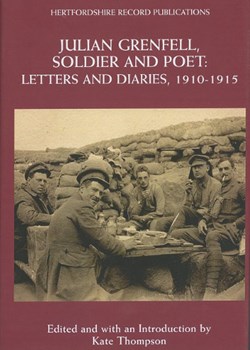Julian Grenfell, soldier and poet: letters and diaries, 1910-1915
- Home
- World War I Book Reviews
- Julian Grenfell, soldier and poet: letters and diaries, 1910-1915

Edited by Kate Thompson
ISBN 978-0-9547561-1-6
Hardback, 362 pp, £25
Available from Hertfordshire Record Society (www.hrsociety.org.uk)
Julian Grenfell is probably best known as the author of the poem Into Battle which was published posthumously in 1915. Grenfell was more than a minor poet; he was a professional pre war soldier serving in the 1st Royal Dragoons, first in India then in South Africa and was to be awarded a posthumous D.S.O. Powerfully built and handsome, standing over 6 feet, Grenfell was a fine sportsman with a zest for life.
Grenfell was the eldest son of Lord and Lady Desborough, of Taplow Court, Buckinghamshire and Panshanger in Hertfordshire; the Panshanger archives being deposited in the Hertfordshire Record office in stages following its demolition in 1953.
Educated at Eton and Balliol College, he was a contemporary of Charles Lister, Edward Horner and Patrick Shaw-Stewart amongst others. His parents belonged to a group known as The Souls, intellectual members of the aristocracy.
The letters mainly to his mother but some to his father and sister Monica begin en route to India in 1910, and describe the life on board ship then the life of a junior officer. Grenfell writes with great enthusiasm of the impressions of service abroad, his impressions of his fellow officers and the social life. Actual soldiering gets very little mention; he writes enthusiastically of pig-sticking and polo which were obviously favourite occupations. His mother was a famous society hostess and he makes frequent references to parties and friends of the family, and is always concerned as to her health.
Grenfell seems to have suffered frequent illness and injury during his early spells in India, taking falls during polo matches and contracting jaundice.
In late 1911 the Dragoons transferred to South Africa. Initially Grenfell appears very unhappy with the life there, missing India sorely. Gradually the letters reveal that he is accepting the life and enjoying trekking with his men and taking part in boxing matches and show jumping.
The Dragoons arrived in England in September 1914 and got to the Western Front in October 1914. Many of the letters are taken up with lists of requests for articles to be sent out to him and the men, but Grenfell also revels in warfare, claiming to adore war. One wonders whether the sentiments would have remained the same if he had lived longer. He is excited by the prospect of his sister arriving at Wimereux to become a nurse and talks of transferring to the Guards, although this was never to come to fruition.
The letters cease with a jaunty note sent to his mother telling her he had stopped a Jack Johnson with his head. This is the last of his letters, but in the appendices are further letters and diaries, Grenfell’s Western Front diary and that of his mother describing the time from his wounding to his death and burial at Boulogne Eastern cemetery. There are also letters of condolence and letters from his commanding officer in the appendix. A short appendix contains the letters to Flossie Garth, a girl that Grenfell was obviously very attached to and who he had spent time with during his last leave.
There are references in the letters to an uneasy relationship between Grenfell and his mother and his displeasure at her relationships with his contemporaries, although the notes do not elaborate on this.
WFA member Kate Thompson has done a very good job editing these letters for publication; notes are at the foot of the page which I always find pleasing and are generally very good. Personally I would have liked to have seen some more illustrations, the one photograph of Grenfell is an excellent one taken in 1915. The book has certainly made me want to read more about the Desboroughs. Recommended.





